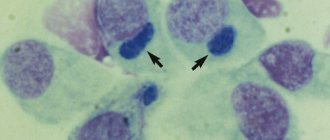How the virus works
Rabies is an infectious disease that affects humans, wild and domestic animals. The causative agent is a virus called Rabies virus, belonging to the Rhabdoviridae family.
When microorganisms enter the bloodstream, they begin to multiply rapidly, first attacking the excretory system, and then affecting the spinal cord and brain. The effect of Rabies virus on neurons leads to their gradual atrophy, which is accompanied by certain symptoms. Rabies cannot be treated and the result is death.
Initial examination at home
If you notice unusual changes in your pet's behavior, it is necessary to conduct an initial examination at home, while observing personal safety rules. To do this, you should wear clothes made of thick, dense fabric that protect open areas of the body, and fabric (knitted) and rubber gloves on your hands.
Important! Such an examination should be carried out after each long absence of the cat from home, even in the absence of visible injuries and strange behavior.
The animal should be carefully examined for damage to the skin and mucous membranes, bites and scratches. Fresh wounds must be cleaned of hair and mechanical impurities, washed with a solution of water and laundry soap in a concentration of 10:1.
Important! Do not treat wounds with alcohol-containing solutions, block the outflow of blood and exudate, or apply a tight bandage (only if there is no threat of significant blood loss).
During this period, contact of the cat with people and pets should be excluded by placing the pet in a cage and a specialized container. After this, you need to seek advice from a veterinary clinic.
Routes of infection
Speaking about the etiology of the disease, it should be noted that the source of infection is an infected animal. There are three main ways of transmitting rabies in cats:
- transmission of infection through the bite of a sick animal;
- contact with the corpse of an animal that died from Rabies virus, eating contaminated meat;
- when saliva or blood gets into wounds, scratches, microcracks, or other damage to the skin.
In rare cases, infection occurs by contact of microorganisms with mucous membranes. However, most animals suffer from rabies after the Rabies virus penetrates into the blood.
Can a domestic cat get rabies?
Those pets that live in the private sector, near park forests, are at risk. So, a cat can be bitten by wild (foxes, raccoons, hedgehogs, wolves) or stray animals, such as dogs.
Infection will occur if a sick mouse was eaten or a predator came across the corpse of an infected rodent (the virus persists in cells for several hours). Signs of rabies can also appear after saliva gets into an open wound of a kitten or adult.
It is impossible to bring a virus on shoes, as many owners think. Infection does not occur by airborne droplets. This is due to the fact that Rabies virus has poor stability in the environment and is sensitive to a certain group of chemicals and drugs. So, he dies from laundry soap, 5% formaldehyde solution, phenol, 0.1% sublimate solution.
When the temperature rises to 50 degrees, destruction occurs within an hour and a half; in frosty conditions, the microorganism can remain viable for 4 months or more.
How can a cat become infected with rabies if it never leaves the apartment, is left to live indoors, and is not allowed out of the house? No way!
If an animal accidentally runs out into the street and is bitten, the saliva of a sick individual gets into the wounds, then infection is possible. The virus can also enter the body through contact with deceased infected creatures.
In kittens, Rabies virus is transmitted through the placenta, but usually sick animals cannot give birth and do not live to give birth.
INTERESTING TO KNOW: Symptoms and treatment of gastritis in cats
Causes of pathology
The name of the rabies virus (obsolete hydrophobia, fear of water) is derived from the Latin “rabies” - “demon”. This is explained by the fact that in ancient times it was believed that evil spirits inhabit a living being, making it possessed.
The neurovirus is not stable in the external environment and survives only at temperatures below minus. When frozen, it remains active for up to 4 months. When boiled, it dies within 2 minutes, so to disinfect clothing that has been exposed to the saliva of an infected animal, simply boil it.
The rabies virus enters the environment through the saliva of an infected individual. A deadly infection is transmitted to a cat through:
- Bites. This is the most common method of infection. First, infected saliva enters the wound. Further, from soft tissues it moves to the nerve fibers and actively develops.
- Abrasions, wounds. Even if the pet has not been bitten, the virus may well enter its body through the affected area of the dermis along with the saliva of the virus carrier.
- Skin, mucous membranes. The virus also enters the body through intact skin due to the presence of microcracks on it.
In addition, your pet can become infected by eating “prey”, for example, a mouse infected with the rabies virus.
The mechanism of action of the virus is as follows: from the site of the bite, it moves first to the spinal cord, causing its inflammation, then to the brain, affecting almost all its parts through the salivary glands. The speed of spread of the virus is approximately 3 mm/hour.
Symptoms
Symptoms of rabies in cats appear gradually in accordance with the stages of the disease. After a bite, the virus penetrates through the nerve trunks to the brain. The incubation period can last from 2 to 6 weeks in cats, most often the clinical picture is observed on days 10-18.
When Rabies virus reaches the cerebral cortex, it will also be present in the saliva of the kitten or cat. It is at this moment that the individual is already capable of infecting other pets, as well as humans.
How does rabies manifest in cats? The disease occurs in three different forms, and animals behave differently.
Symptoms and development of the disease
Rabies attacks the brain, resulting in quite characteristic behavioral changes. From the initial symptom, the cat will go through three stages of disease progression: prodromal (melancholic), manic (excited), and paralytic. Each of the three stages is characterized by different symptoms - the virus slowly makes its way into the brain, simultaneously affecting almost the entire body.
The prodromal stage can last from two to ten days. At this stage, the cat will change its temperament and become the complete opposite of its usual behavior. For example, an active, happy cat will suddenly become lethargic and unhappy. She will start hiding, stop showing interest in food, become irritable or, on the contrary, hyperactive. Other symptoms may also occur: chills, fever, vomiting, diarrhea, cough.
Manic stage. At this stage of rabies, the cat becomes overly aggressive, grinning at the slightest contact, baring its claws and trying to attack you. She will be overexcited, as you can see by looking into her eyes: her pupils will begin to dilate. The animal will be irritated by light, noise and the slightest movement. All this will be a challenge for her to attack. The manic stage is often also called the insanity stage because the cat begins to act as if it has gone crazy. And look the part. Continuous excessive drooling, dilated pupils, muscle spasms and aggressive behavior are the most striking symptoms of this stage of rabies. A feature of the manic stage is hydrophobia - the cat begins to be afraid of water and even its sounds. It is at this stage that the disease is most often transmitted to humans.
The paralytic stage begins seven days after the onset of the disease (stage one) and is characterized by loss of the ability to move the muscles of the jaw and throat. The cat will continue to show the obvious symptom of the disease: drooling. But he won't be able to swallow saliva. Aggression will be replaced by depression and complete loss of strength. The paralysis will slowly move from the throat and jaw to other parts of the body, eventually leading to death over the next few hours.
Violent form
The cat loses its appetite, it tries not to approach its owner, and does not respond to its name. But it happens that a cat becomes suspiciously affectionate. Then, fearfulness or aggression towards the owner may suddenly arise;
She will scratch the bite site and may swallow an inedible object. Will refuse to drink due to throat spasms. Heavy salivation will begin. Sudden fits of rage will appear. The cat will rush at the person, bite and scratch;
Then the cat’s aggressive state will change to a depressed one. She, exhausted, will lie quietly. But she will again rush at people if she hears even a faint sound;
The animal will refuse any food and lose weight, the voice will disappear, the jaw will drop, the tongue will fall out of the mouth. The cornea of the eyes will become cloudy, and squint will appear. The hind legs will fail, and then the front legs. Paralysis will affect the internal organs. The cat will die within a week.
Paralytic or silent form
This form in cats lasts from 2 to 4 days. With this form of the disease, the cat can be very affectionate, constantly rubbing itself near the owner. At this moment, the cat already has the rabies virus in its saliva, thereby creating a direct threat to human life.
At the beginning of the disease, the cat may bite. Subsequently, the cat becomes restless, then becomes depressed. With this form of the disease, what cat owners usually pay attention to is a sagging lower jaw, difficulty swallowing and profuse drooling.
As a result of gradually developing paralysis of the lower jaw and pharynx, the owner thinks that the cat has choked on a bone, first tries to remove it himself and, having failed to do this, often goes to the veterinary clinic. When trying to remove a supposed bone, the animal owner exposes himself to the mortal danger of contracting the rabies virus. Cats with this form of the disease may develop hemorrhagic gastroenteritis.
Atypical form of rabies
is quite rare. Characterized by depression, general lethargy, drowsiness. The cat does not eat well, vomiting, constipation or diarrhea may appear, and sometimes convulsive trembling in different parts of the body. The illness may last for several months. Rabies in kittens is symptomatically no different from the disease in adult animals, with one exception: the virus acts faster, and the disease usually lasts only a few days.
Violent form - main symptoms
There are three stages of the impact of infection on the body: prodromal, manic, depressive.
At the first stage, characteristic signs can help identify rabies in a cat:
- significant change in mood;
- constant need for the owner’s attention, the need for the animal to be stroked;
- the pet rubs its head against the human body;
- frequent licking of the skin.
Other first signs of rabies in cats also appear:
- increased drowsiness;
- fear of light and desire to hide in a dark and deserted place;
- refusal to eat, loss of appetite;
- food interest in inedible objects;
- digestive disorders (vomiting, diarrhea, salivation);
- itching at the site of the bite.
How long do cats with rabies remain in this state? The stage lasts 2-4 days.
The next stage is manic. Rabid adult cats do not yet become lethargic, but symptoms should already appear in a more pronounced form. You can recognize them after observing the pet’s condition:
- change in the appearance of the fur on the lower jaw (wetness, dishevelment);
- severe fear of water and light;
- complete refusal to eat;
- aggression towards people and the owner, the desire to scratch or bite;
- drooping of the lower jaw;
- the pupils change position, strabismus develops;
- Paralysis of the paws and larynx occurs.
Rabies in an adult cat causes fear and anxiety in the owner, as the animal becomes inadequate and does not respond to the human voice, calls or punishment. It is not possible to lure or calm with the help of “sweets”.
With rabies, the individual remains in the manic stage for 2-5 days.
The final stage is depressive. The animal can no longer lead an active lifestyle, severe apathy is observed, the pet begins to tremble convulsively, the tremor does not stop until death. Hoarseness is heard when inhaling and exhaling, it seems that a lump has formed in the throat.
Rabies in any cat ultimately ends in death, caused by general exhaustion of the body due to refusal of food and respiratory arrest. Death occurs within 1-3 days.
Light form
It is also called silent and is also known as the paralytic form. It differs in that the symptoms described above are not noticeable, since they do not appear clearly. In some cases, the owner manages to find out about the disease by closely monitoring the pet. He may become more affectionate if he previously did not show much interest in people and did not caress, tries to be constantly nearby, tries to sleep on the person’s body.
In this case, rabies in cats and the symptoms are hidden. The disease manifests itself unexpectedly and sharply, the signs become:
- pharynx paralysis;
- increased salivation;
- the cat is trying to cough something up;
- the animal appears to be choking.
At this point, it is already useless to look for how to determine rabies in a cat and methods of treatment, since after 2-4 days the individual will die.
How can a cat become infected with rabies?
There is some debate about how rabies is transmitted from cats. Some experts believe that it is transmitted only if bitten by a carrier, but this is not entirely true. A cat can also become infected through scratches, since these animals often lick themselves with a large amount of saliva, some of which remains under the claws.
It is through the salivary fluid that cats and other animals become infected with rabies, and not at all through the blood.
A cat can “catch” this fatal disease if it is let out for a walk near the entrance or in the country. In addition to the fact that the virus is carried by cats, stray dogs, foxes, raccoons, wolves, hedgehogs, and rodents can infect a domestic cat.
Having caught a mouse, mole or rat infected with rabies, a pet can easily become infected if even a minimal amount of rodent saliva gets into its mouth or digestive tract. There may be microscopic wounds in the mouth and esophagus through which the virus can enter.
Kittens can be infected from a sick mother. In them, the disease progresses rapidly and symptoms can be expressed almost immediately, so the causes of rabies in cats should be known to every owner.
Can a domestic cat get rabies?
Rabies in a domestic cat is a rare occurrence if it does not leave the apartment. But a reclusive life is not a panacea for this disease. There are unforeseen situations, for example, a cat jumped out of the apartment during the rutting period and got into a fight with a basement cat, or had sexual contact with an infected cat that lives on the street.
A domestic kitten bought secondhand may not show signs of rabies, but no one can guarantee that it is not infected. A baby can die within a few days without leaving home, and few people would think that the cause is the Rabies lyssavirus virus.
Ways of infection of domestic cats are the bite of a virus carrier, contact with saliva on the wounded surface of the skin, and eating small rodents. A timely vaccinated cat is the only protection not only for the pet itself, but also for the people around it.
Atypical form of rabies in an adult cat
The most difficult to diagnose and dangerous for humans, since the incubation period of rabies in cats is hidden. First, the animal shows signs of digestive upset, which forces you to contact a veterinarian and undergo an examination. Symptoms:
- diarrhea and loose stools;
- vomit;
- indifference to the environment;
- feces may come out with blood;
- exhaustion of the body.
INTERESTING TO KNOW: Why is gingivitis dangerous in cats?
Can a cat infect its owner? If a pet develops rabies in this form, the owner runs a very high risk of contracting rabies because he is unaware of the danger. The duration of existence of the pathology in this form is up to 3 months.
Vaccinating cats against rabies: when to vaccinate
There is no cure for rabies. The only way to avoid the disease is timely vaccination. The vaccination is given to a kitten at the age of 3 months.
The animal must be healthy. 2 weeks before the injection, the kitten must be given anthelmintic drugs.
Vaccines that have proven positive:
- Rabikan;
- Quadriket;
- Leucoriphenin;
- Nobivak.
Be sure to read:
Immunodeficiency in cats: description, stages, symptoms, how to treat, what is FIV, is it dangerous?
They are easily tolerated by cats and do not cause discomfort. Before the first vaccination, contact of the animal with sick individuals should be avoided.
It is not advisable to let your cat outside. Vaccinations in Russia are provided free of charge in state veterinary clinics.
Analysis and diagnostics
When determining whether an animal has rabies or not, it is important not to confuse the symptoms with other health conditions, since an incorrect diagnosis can cost a person his life (if the cat attacks him).
The difficulty of diagnosis lies in the fact that it is impossible to say for sure whether there was an infection or not until the death of the individual. An analysis of saliva and cerebrospinal fluid for rabies in cats does not always allow us to say with 100% certainty that the virus has not entered the cells.
If there is a suspicion of infection, then first of all the pet must be isolated from people and other animals for a period of 10 to 30 days. After death or euthanasia, the corpse of the quadruped is opened and the brain tissue is examined to determine the presence of the pathogen.
If the result is positive, Babes-Negri bodies will be detected in the form of bubbles with liquid. In Russia, tests for pets are most often not organized, but only signs and symptoms are assessed.
When an animal arrives at a veterinary clinic, it is assessed according to several parameters:
- are there any bite marks on the body, is the cat trying to lick certain areas of the fur;
- whether any changes in behavior are noticeable;
- what is the reaction to stimuli, is there any aggressiveness;
- whether there is a fear of water or light;
- amount of saliva released;
- presence or absence of appetite;
- preferred body position;
- coordination of movements.
Symptoms and signs of rabies
Symptoms of rabies include the following:
- sudden changes in behavior (anxiety, excessive activity of the cat or lethargy combined with lethargy);
- inadequate reaction to stimuli (sounds, owner’s behavior, etc.), search for a dark, secluded place;
- the cat’s desire to scratch the bite site or sore through which the infection entered the body;
- loss of interest in usual food, toys;
- copious secretion of saliva, which is determined by the fur sticking together around the muzzle;
- disorders of the gastrointestinal tract (prolonged diarrhea, vomiting, bleeding in feces, etc.);
- drooping of the lower jaw;
- swallowing disorders, hydrophobia;
- loud meowing, which at the last stage turns into loss of voice due to spasm of the pharynx;
- convulsions;
- paw paralysis
The clinical picture and life expectancy of a sick animal depends on the form of the disease.
Treatment
Rabies in cats, wild animals and humans has no cure. Those suspected of being infected with the virus should be isolated. Pets must be euthanized and corpses must be burned.
If a rabid cat has bitten or scratched the owner, he should wash the skin and wound with water and an alkaline solution (for example, laundry soap), and go to the hospital as soon as possible. Next, the patient is prescribed a course of injections and antibiotics. A sick cat cannot be saved in the same way.
Incubation period for rabies in cats
Rabies in cats that live at home is less common than in street and wild animals.
This is because the virus is transmitted through contact between the saliva and blood of a healthy cat, and is not airborne or carried on the soles of shoes and items of clothing.
Stages of infection in animals and humans.
However, some owners let their cats go for walks or keep them with animals that require regular walks (for example, dogs). In the absence of vaccinations for a walking animal, this sharply increases the risk of infection.
An infected cat poses a danger to people not only at the moment when the first symptoms of rabies begin to appear, but also during the latent (incubation) period. Until the pathogen has affected the central nervous system and spinal cord, the animal may seem completely healthy and not show aggression, but its saliva already contains dangerous virions.
The latent period of rabies lasts from 1 week to several months, in rare cases - up to a year. Most often it lasts no more than 2-3 weeks.
The duration of the incubation period of the disease depends on the age of the animal and the location of introduction of the pathogen. When an adult cat is infected, several weeks may pass from the moment of infection to the appearance of symptoms, but in a kitten the incubation period takes no more than 7 days.
Penetration of the virus through bites and sores on the head can quickly lead to damage to the nervous system.










